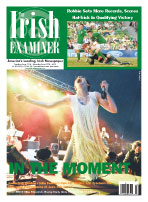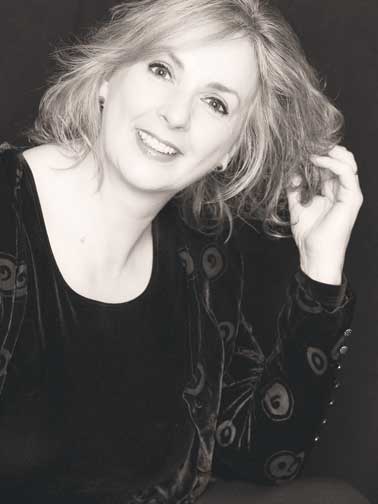


SERVICES
Tuesday September 21, 2010
A Musical People, At Home And Abroad!
Moya Brennan - The host of 'Music of Ireland - Welcome to America' (Mella Travers) By Gwen Orel "I love Irish music." What does that mean? Do you love trad, pop, rock? As part two of Moya Brennan's extraordinary documentary produced for PBS, Music of Ireland, makes clear-specializing is, well, beside the point. Brennan should know - she began her career as the harpist/ethereal singer of Clannad (spelling her name traditionally as Maire). Only Clannad was always progressive - keeping the tradition living - adding jazz riffs, harmonies that were contemporary. They did a lot of television and movie scores along the way, and younger sis Enya made a career of Celtic-inspired but definitely new age sounds. Through her career Moya has met everyone, and both parts of the documentary have a great, intimate feeling of her talking to her friends. The documentary began airing in the New York area on Friday, September 17th - check your local listings for when it's on in your area. It's not to be missed. So good is it that anyone who likes any kind of Irish music should have it in their library. Get the DVD/CD by pledging public television, even if you watch nothing else this year. Like the first half of the documentary, Music of Ireland - Welcome Home, which aired in May (check out my interview with Moya for this paper, May 17), the second part includes snippets of performances and interviews with many performers. Some of them you'll have heard of - U2's Bono, Sinéad O'Connor, Celtic Woman, the Corrs, and some might be new to you, like The Script - but all offer insight and a piece of the kaleidoscopic picture that creates the shifting musical scene in Ireland. Music of Ireland - Welcome to America, as part two is titled, goes from Clare to America. America is where rock legends are made, it's the home of rock and roll and every rocker's dream destination. So tracing contemporary Irish artists through their American reception makes sense. It's also fresh. The musical conversation between American roots and Irish trad has been explored many times - but now how the US informs and supports Irish rock. The documentary starts out by looking at U2, from its early appearances on Irish television (check out Bono's mullet!) to its first tours of the US, and first stadium appearances. Bono explains how playing huge arenas helped the band realize they needed more rhythmic variety, too. For Moya, programs like this "explain a bit of people's thoughts." It's not that you could ever get to the bottom of why music from such a small country has become so influential. She points out that people know Irish music that don't even know they know it - from commercials, blockbusters like The Titanic and TV (I vividly remember a car commercial that used one of Susan McKeown's songs). Because it is such a small country, she says, she was able to sit down as a friend "with 98% of the people you see on the show." Ireland's small size means that artists meet and inspire each other. It also means that audiences are eclectic too. "You're a huge country," says Moya. "You have a box for everything. If you play some kind of music, it tends to be put in a certain box, people in that box might get to know each other. There's only one chart here, and it might have some ballad singer, young kids singing something traditional, a rock song on it. There are stations that might play more rock, but still might include some Irish artist because it's popular. That's why we all know each other." Dublin, she points out, has half a million people (compare and contrast 8.4 million in New York, 3.8 million in Los Angeles). The lack of variety on television also contributed to Ireland's musical strength. "The Late Late Show", on Friday night, is a two hour show. It might have three or four different musical acts; it could be Sharon Corr doing a cover of something, a Polish band, a group of traditional musicians from an event that's on down in the country." People still watch local TV first. Everyone would also know "who's had a book out, what topic of conversation is it that week." As she pointed out in part one, which included scenes of children competing at a fleadh, "how you'd regard sports as part of your schooling and education, music is to us. You'd hear hundreds of songs growing up, it automatically becomes part of your being. In the rural countryside, there wouldn't be big cities around, it's more accessible to you to be part of that. If you go into a bar for a quiet pint you'll always find music there. You can't get away from it!" For Damien Dempsey, programs like this "pass down the music, which has been passed on for generations, to younger kids - and pays tribute to some of the older legends. This gives Irish America a taste of the real stuff coming out of Ireland." Dempsey is not so well known yet as Bono, but he's a musician's musician - his fans are passionate and enthusiastic. In the documentary, he talks about his influences, which include Liam Clancy (in part one, Clancy talked to Moya about his career shortly before he died); Planxty; the Dubliners - and sings a new version of his hit, "Massai" (which is also on the CD). The Irish love music, Dempsey says, because "it helps us get through hard times. When we had no voice, no vote, no power and no land, music was the way we got through. It's a very spiritual thing." His fans "sort of push my music, drive people along to the shows, indoctrinate others. It's how my music spreads. The lyrics mean a lot to them, they come from experience, from the heart. They take you to Hell and back, but there's always a chink of hope at the end. People tell me it helps them through hard times, tell me 'that song saved me.'" Dempsey considers what he does "rebel music" - only his songs take on not colonialism but greed, deprivation, drugs, the excesses of the Celtic Tiger and the destruction in its wake. The documentary also looks at Sinéad O'Connor's career, including her notoriously ripping up a picture of the Pope on Saturday Night Live - years before the church abuse scandals hit the front pages and explained why she blamed the church for child abuse. One of the scenes shows her being booed off the stage at Madison Square Garden. Larry Kirwan, from Black 47, was there for the Dylan Fest that night (check out my interview with Kirwan for this paper May 6). "I still think it was a mistake for her to walk off. The booing was pretty minimal from what I remember, although I've been told that it seemed a lot more intense onstage." He's also featured in the documentary, as a version of Irish music merging with a new form - rap - and how it ignited fans in New York. The documentary, says Kirwan, shows up how manipulative music videos have become, by showing what really happens behind the scenes. One thing America has to offer are music Festivals - some are traditional music festivals; others, like the one in Dublin, Ohio, have a little bit of everything - Irish pop, Irish trad, and world music with Irish flavors, like Salsa Celtica. The documentary visits the Dublin Festival, and also shows Screaming Orphans (check out interview for this paper May 21), four sisters whose rock and trad sounds merge elegantly together. Festivals like these, says Moya, are "a huge support for Irish music, and Irish artists that go from Ireland to America. The root of it really is Irish music - but there are fewer in Ireland, probably because of the weather. There are Irish acts, but also acts that have never been on Irish soil. It's amazing how Irish music has had such an influence on such a cross section of people." Moya played at Dublin, Ohio for this first time this past year. She had a great time, and enjoyed the Celtic rock in particular. "Years ago some people would have been cautious about crossover destroying this music, but the music is so strong it just always adds and makes it interesting." Damien Dempsey's music, for example, has elements of trad, rock and reggae. And that is really Irish, as he explains: "There's a strong connection between the Caribbean and Ireland. A lot of Irish were sent there as slaves by Oliver Cromwell, there were a lot of women left without husbands. And when the Irish went to England to work in the '50s, after World War II, the Irish and the Jamaicans were treated the same - and they became good friends." Dempsey has a lot of trad in his background though - his ipod includes Planxty along with Bob Marley and Johnny Cash. He grew up at sessions. With so much eclecticism, what connects Irish pop music? Dempsey says, "Irish singers sing from the heart - they can make the hair stand up at the back of your head and tear your heart out with a song. If you go to a house party where I live, everybody sings - there's a lot of emotion in the music." His voice is strong an unmistakeable - "a bit of a foghorn," he laughs. Colin Devlin, whom I interviewed last week (he was here for the Wee Craic Fest), hears longing and melancholy in those voices. Moya thinks "melodies are really important-that's a strong influence, even in rock bands." While people find their influences in different places, everyone "grows up surrounded by music all the time in this country. People allow it to come to them." "If you come here and play an instrument, you'll bump into somebody who will play with you. You can't escape it!" |
CURRENT ISSUE

RECENT ISSUES


SYNDICATE
[What is this?]
POWERED BY

HOSTED BY

Terms of Service | Privacy Policy
Website Design By C3I






